Abstract
1 The site of action of 5-hydroxytryptamine (5-HT) was examined on the isolated muscularis mucosae attached to the submucous plexus of the guinea-pig oesophagus. Isotonic responses of the longitudinal muscularis mucosae were recorded.
2 5-HT produced a transient contraction of the muscularis mucosae at concentrations higher than 3 μM. The contraction was rapid in onset, reaching a peak in about 15 s or less, and was restored to the basal level after 20 to 30 s without washing out 5-HT. When the 5-HT-induced contraction faded to the basal tone, successive applications of 5-HT no longer produced any contracture.
3 Nicotine (Nic), at concentrations higher than 10 μM, also produced a transient contraction which had a very similar pattern to that induced by 5-HT. Again, the successive application of Nic no longer produced any contracture following prior treatment with Nic itself. However, the 5-HT-induced contraction was not modified by the presence of Nic.
4 Exogenously applied acetylcholine (ACh) produced a concentration-dependent contraction of the muscularis mucoase, the 50% effective concentration (EC50) was 69 ± 5.6 nM. The contraction was sustained during incubation with ACh, and was not modified by prior treatment with 5-HT or Nic.
5 The 5-HT (100 μM)-induced contraction was completely abolished by tetrodotoxin (0.2 μM) and atropine (0.2 μM). This means that the action is mediated by stimulating cholinergic nerves in the submucous plexus attached to muscularis mucosae. Moreover, the stimulating action of 5-HT does not involve nicotinic receptors, since the action was not blocked by hexamethonium (100 μM).
6 Among several 5-MT antagonists examined, methysergide (1 μM), ketanserin (1 μM) and morphine (100 μM) failed to modify the 5-HT (100 μM)-induced contraction significantly. Cinanserin (0.1-3 μM), cyproheptadine (3-100 nM) and phenoxybenzamine (0.1-3 μM) inhibited the 5-HT-induced contraction, in a concentration-dependent manner, and each highest concentration abolished the response. However, none of these antagonists was specific for 5-HT, but the Nic (100 μM) or ACh (0.1 μM)-induced contractions were also inhibited by them.
7 The present results indicate that 5-HT contracts the muscularis mucosae of the guinea-pig oesophagus indirectly by stimulating cholinergic nerves in the submucous plexus, and has no direct action on the muscularis mucosae. In addition, the type of 5-HT receptors responsible for the stimulant action may be different from those in other parts of the gastrointestinal tract, blood vessels or brain, because of the different effects of 5-HT antagonists.
Full text
PDF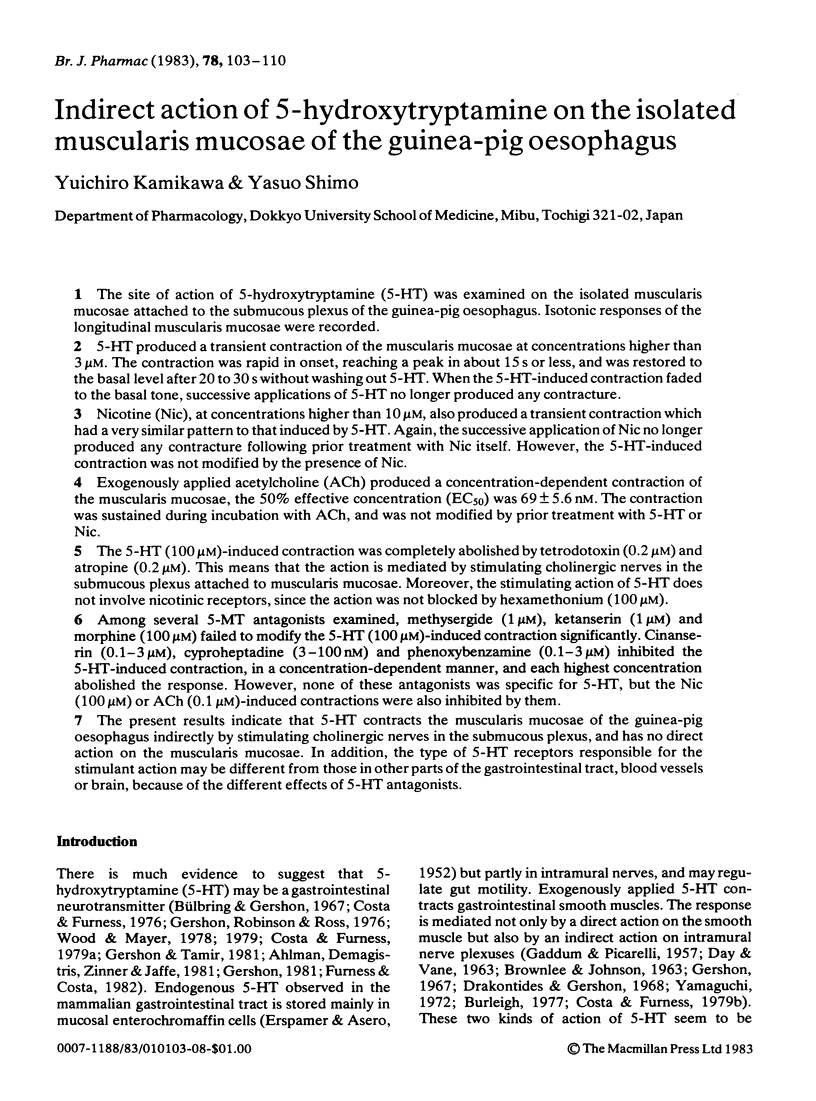
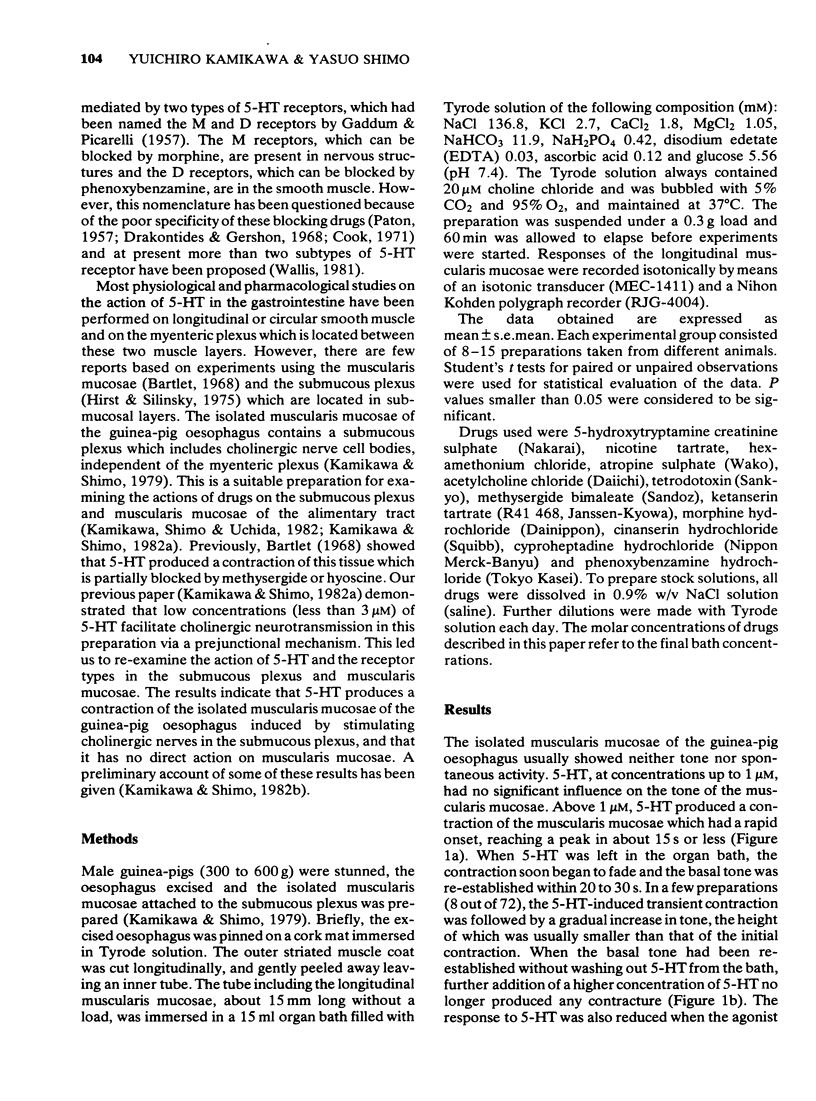
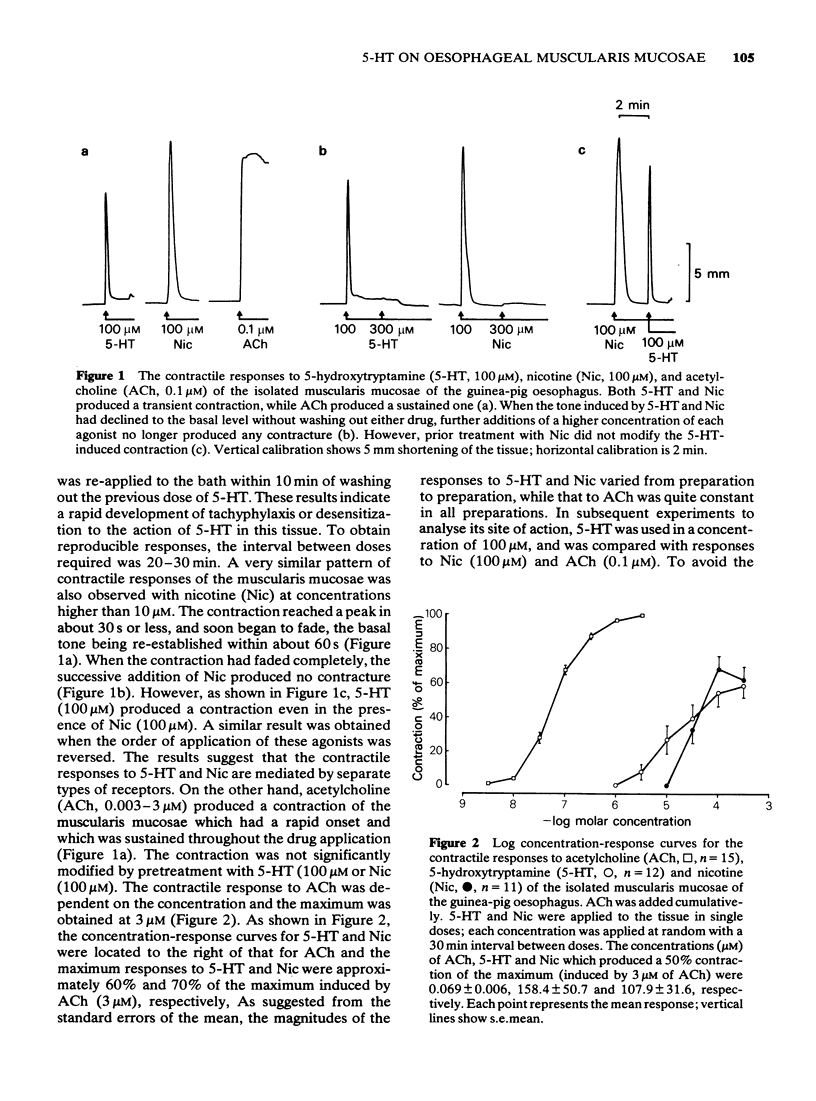
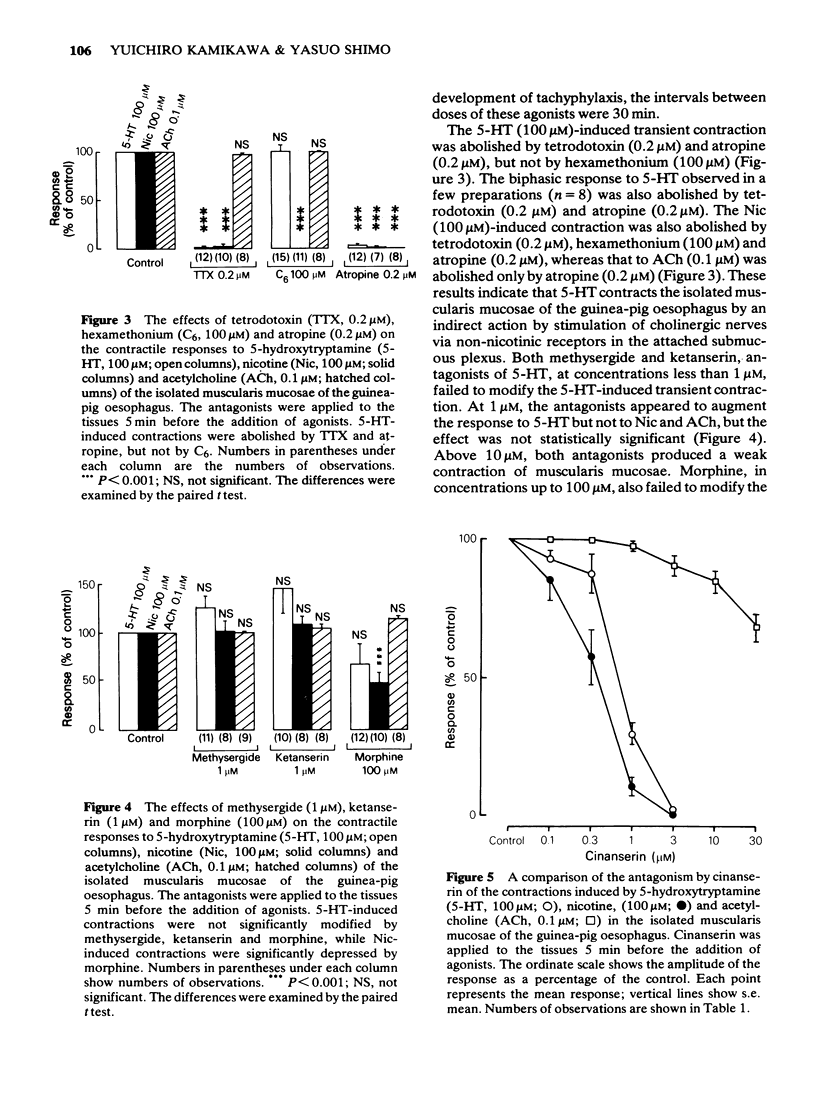

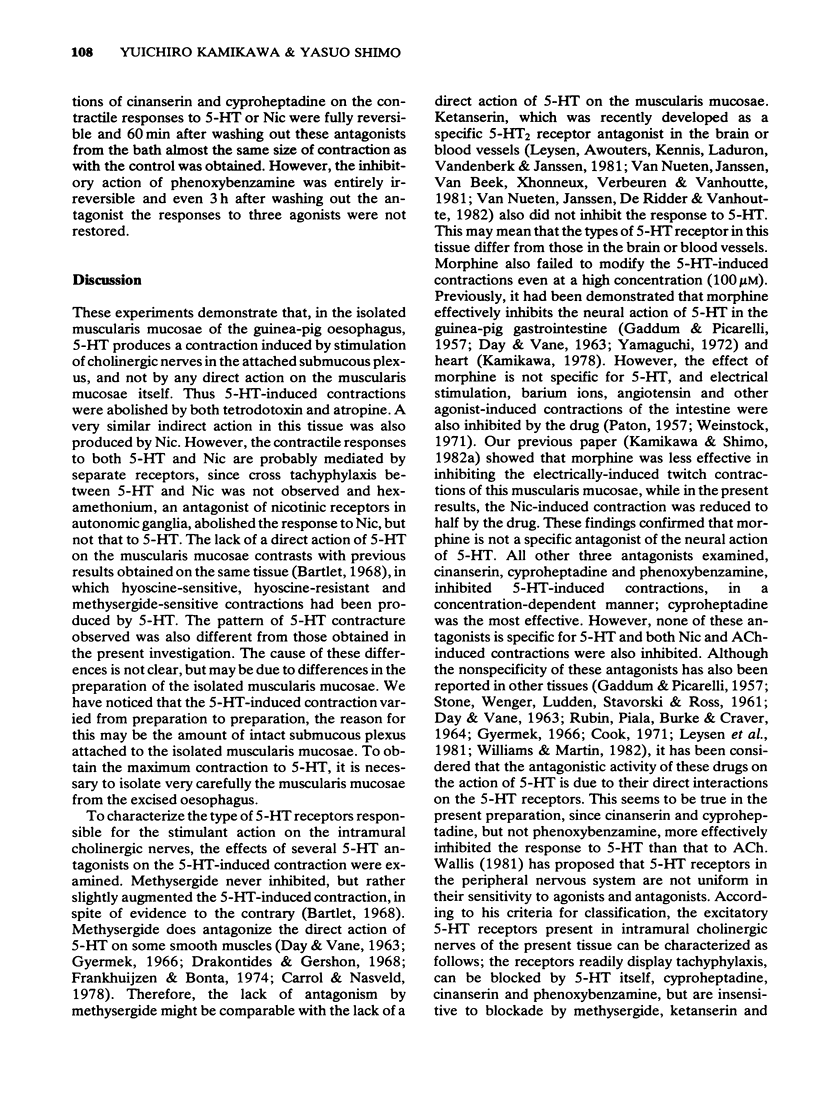
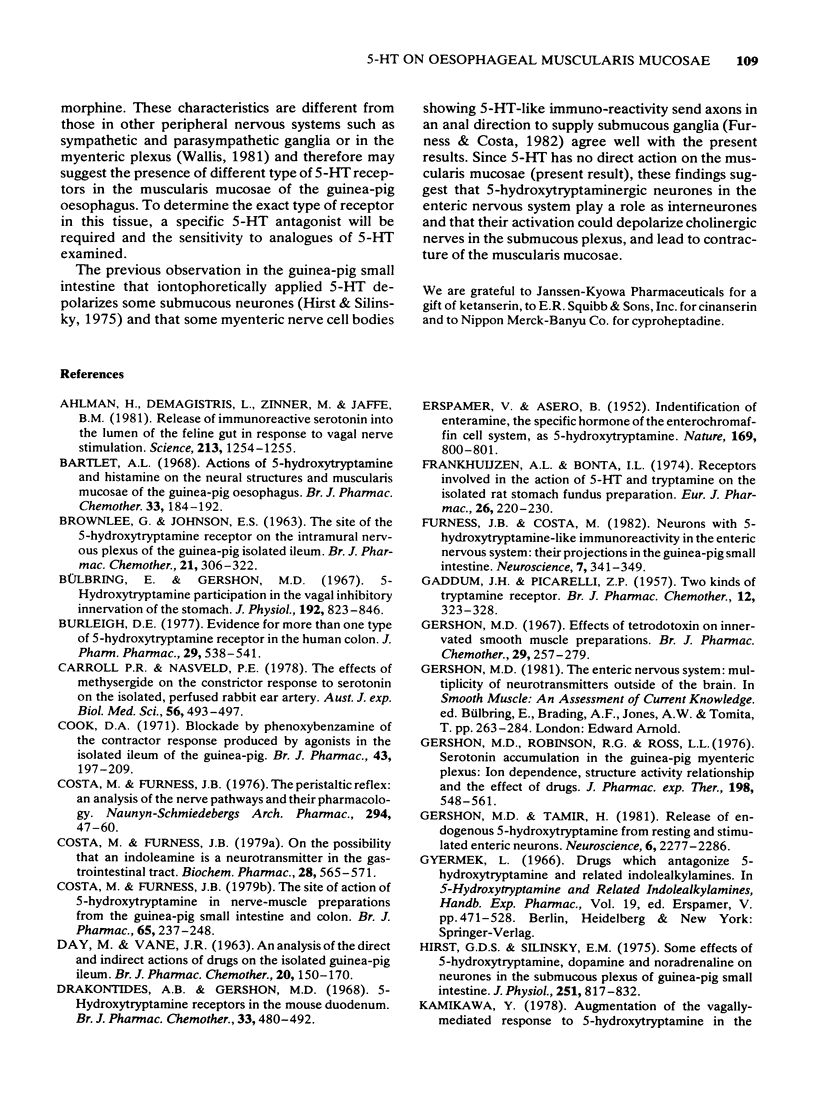
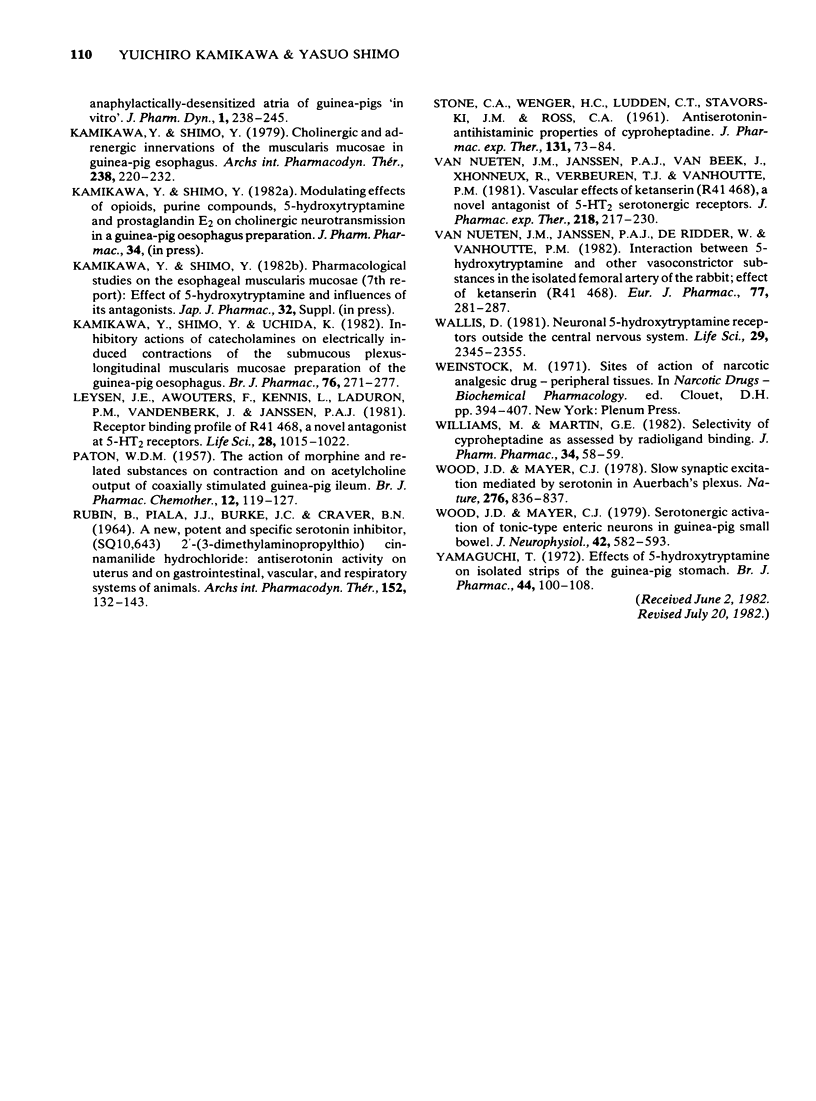
Selected References
These references are in PubMed. This may not be the complete list of references from this article.
- Ahlman H., DeMagistris L., Zinner M., Jaffe B. M. Release of immunoreactive serotonin into the lumen of the feline gut in response to vagal nerve stimulation. Science. 1981 Sep 11;213(4513):1254–1255. doi: 10.1126/science.6168020. [DOI] [PubMed] [Google Scholar]
- BROWNLEE G., JOHNSON E. S. THE SITE OF THE 5-HYDROXYTRYPTAMINE RECEPTOR ON THE INTRAMURAL NERVOUS PLEXUS OF THE GUINEA-PIG ISOLATED ILEUM. Br J Pharmacol Chemother. 1963 Oct;21:306–322. doi: 10.1111/j.1476-5381.1963.tb01529.x. [DOI] [PMC free article] [PubMed] [Google Scholar]
- Bartlet A. L. Actions of 5-hydroxytryptamine and histamine on the neural structures and muscularis mucosae of the guinea-pig oesophagus. Br J Pharmacol Chemother. 1968 May;33(1):184–192. doi: 10.1111/j.1476-5381.1968.tb00487.x. [DOI] [PMC free article] [PubMed] [Google Scholar]
- Burleigh D. E. Evidence for more than one type of 5-hydroxytryptamine receptor in the human colon. J Pharm Pharmacol. 1977 Sep;29(9):538–541. doi: 10.1111/j.2042-7158.1977.tb11391.x. [DOI] [PubMed] [Google Scholar]
- Bülbring E., Gershon M. D. 5-hydroxytryptamine participation in the vagal inhibitory innervation of the stomach. J Physiol. 1967 Oct;192(3):823–846. doi: 10.1113/jphysiol.1967.sp008334. [DOI] [PMC free article] [PubMed] [Google Scholar]
- Carroll P. R., Nasveld P. E. The effects of methysergide on the constrictor response to serotonin on the isolated, perfused rabbit ear artery. Aust J Exp Biol Med Sci. 1978 Aug;56(4):493–497. doi: 10.1038/icb.1978.55. [DOI] [PubMed] [Google Scholar]
- Cook D. A. Blockade by phenoxybenzamine of the contractor response produced by agonists in the isolated ileum of the guinea-pig. Br J Pharmacol. 1971 Sep;43(1):197–209. doi: 10.1111/j.1476-5381.1971.tb07169.x. [DOI] [PMC free article] [PubMed] [Google Scholar]
- Costa M., Furness J. B. On the possibility that an indoleamine is a neurotransmitter in the gastrointestinal tract. Biochem Pharmacol. 1979 Mar 1;28(5):565–571. doi: 10.1016/0006-2952(79)90136-9. [DOI] [PubMed] [Google Scholar]
- Costa M., Furness J. B. The peristaltic reflex: an analysis of the nerve pathways and their pharmacology. Naunyn Schmiedebergs Arch Pharmacol. 1976 Jul;294(1):47–60. doi: 10.1007/BF00692784. [DOI] [PubMed] [Google Scholar]
- Costa M., Furness J. B. The sites of action of 5-hydroxytryptamine in nerve-muscle preparations from the guinea-pig small intestine and colon. Br J Pharmacol. 1979 Feb;65(2):237–248. doi: 10.1111/j.1476-5381.1979.tb07824.x. [DOI] [PMC free article] [PubMed] [Google Scholar]
- DAY M., VANE J. R. An analysis of the direct and indirect actions of drugs on the isolated guinea-pig ileum. Br J Pharmacol Chemother. 1963 Feb;20:150–170. doi: 10.1111/j.1476-5381.1963.tb01306.x. [DOI] [PMC free article] [PubMed] [Google Scholar]
- Drakontides A. B., Gershon M. D. 5-hydroxytryptamine receptors in the mouse duodenum. Br J Pharmacol Chemother. 1968 Jul;33(3):480–492. doi: 10.1111/j.1476-5381.1968.tb00496.x. [DOI] [PMC free article] [PubMed] [Google Scholar]
- ERSPAMER V., ASERO B. Identification of enteramine, the specific hormone of the enterochromaffin cell system, as 5-hydroxytryptamine. Nature. 1952 May 10;169(4306):800–801. doi: 10.1038/169800b0. [DOI] [PubMed] [Google Scholar]
- Frankhuijzen A. L., Bonta I. L. Receptors involved in the action of 5-HT and tryptamine on the isolated rat stomach fundus preparation. Eur J Pharmacol. 1974 May;26(2):220–230. doi: 10.1016/0014-2999(74)90231-3. [DOI] [PubMed] [Google Scholar]
- Furness J. B., Costa M. Neurons with 5-hydroxytryptamine-like immunoreactivity in the enteric nervous system: their projections in the guinea-pig small intestine. Neuroscience. 1982 Feb;7(2):341–349. doi: 10.1016/0306-4522(82)90271-8. [DOI] [PubMed] [Google Scholar]
- GADDUM J. H., PICARELLI Z. P. Two kinds of tryptamine receptor. Br J Pharmacol Chemother. 1957 Sep;12(3):323–328. doi: 10.1111/j.1476-5381.1957.tb00142.x. [DOI] [PMC free article] [PubMed] [Google Scholar]
- Gershon M. D. Effects of tetrodotoxin on innervated smooth muscle preparations. Br J Pharmacol Chemother. 1967 Mar;29(3):259–279. doi: 10.1111/j.1476-5381.1967.tb01958.x. [DOI] [PMC free article] [PubMed] [Google Scholar]
- Gershon M. D., Robinson R. G., Ross L. L. Serotonin accumulation in the guinea-pig myenteric plexus: ion dependence, structure-activity relationship and the effect of drugs. J Pharmacol Exp Ther. 1976 Sep;198(3):548–561. [PubMed] [Google Scholar]
- Gershon M. D., Tamir H. Release of endogenous 5-hydroxytryptamine from resting and stimulated enteric neurons. Neuroscience. 1981;6(11):2277–2286. doi: 10.1016/0306-4522(81)90017-8. [DOI] [PubMed] [Google Scholar]
- Hirst G. D., Silinsky E. M. Some effects of 5-hydroxytryptamine, dopamine and noradrenaline on neurones in the submucous plexus of guinea-pig small intestine. J Physiol. 1975 Oct;251(3):817–832. doi: 10.1113/jphysiol.1975.sp011124. [DOI] [PMC free article] [PubMed] [Google Scholar]
- Kamikawa Y., Shimo Y. Cholinergic and adrenergic innervations of the muscularis mucosae in guinea-pig esophagus. Arch Int Pharmacodyn Ther. 1979 Apr;238(2):220–232. [PubMed] [Google Scholar]
- Kamikawa Y., Shimo Y., Uchida K. Inhibitory actions of catecholamines on electrically induced contractions of the submucous plexus-longitudinal muscularis mucosae preparation of the guinea-pig oesophagus. Br J Pharmacol. 1982 Jun;76(2):271–277. doi: 10.1111/j.1476-5381.1982.tb09217.x. [DOI] [PMC free article] [PubMed] [Google Scholar]
- Leysen J. E., Awouters F., Kennis L., Laduron P. M., Vandenberk J., Janssen P. A. Receptor binding profile of R 41 468, a novel antagonist at 5-HT2 receptors. Life Sci. 1981 Mar 2;28(9):1015–1022. doi: 10.1016/0024-3205(81)90747-5. [DOI] [PubMed] [Google Scholar]
- PATON W. D. The action of morphine and related substances on contraction and on acetylcholine output of coaxially stimulated guinea-pig ileum. Br J Pharmacol Chemother. 1957 Mar;12(1):119–127. doi: 10.1111/j.1476-5381.1957.tb01373.x. [DOI] [PMC free article] [PubMed] [Google Scholar]
- RUBIN B., PIALA J. J., BURKE J. C., CRAVER B. N. A NEW, POTENT AND SPECIFIC SEROTONIN INHIBITOR, (SQ 10,643) 2'-(3-DIMETHYLAMINOPROPYLTHIO) CINNAMANILIDE HYDROCHLORIDE: ANTISEROTONIN ACTIVITY ON UTERUS AND ON GASTROINTESTINAL, VASCULAR, AND RESPIRATORY SYSTEMS OF ANIMALS. Arch Int Pharmacodyn Ther. 1964 Nov 1;152:132–143. [PubMed] [Google Scholar]
- Van Nueten J. M., Janssen P. A., De Ridder A., Vanhoutte P. M. Interaction between 5-hydroxytryptamine and other vasoconstrictor substances in the isolated femoral artery of the rabbit; effect of ketanserin (R 41 468). Eur J Pharmacol. 1982 Feb 5;77(4):281–287. doi: 10.1016/0014-2999(82)90130-3. [DOI] [PubMed] [Google Scholar]
- Van Nueten J. M., Janssen P. A., Van Beek J., Xhonneux R., Verbeuren T. J., Vanhoutte P. M. Vascular effects of ketanserin (R 41 468), a novel antagonist of 5-HT2 serotonergic receptors. J Pharmacol Exp Ther. 1981 Jul;218(1):217–230. [PubMed] [Google Scholar]
- Wallis D. Neuronal 5-hydroxytryptamine receptors outside the central nervous system. Life Sci. 1981 Dec 7;29(23):2345–2355. doi: 10.1016/0024-3205(81)90470-7. [DOI] [PubMed] [Google Scholar]
- Williams M., Martin G. E. Selectivity of cyproheptadine as assessed by radioligand binding. J Pharm Pharmacol. 1982 Jan;34(1):58–59. doi: 10.1111/j.2042-7158.1982.tb04682.x. [DOI] [PubMed] [Google Scholar]
- Wood J. D., Mayer C. J. Serotonergic activation of tonic-type enteric neurons in guinea pig small bowel. J Neurophysiol. 1979 Mar;42(2):582–593. doi: 10.1152/jn.1979.42.2.582. [DOI] [PubMed] [Google Scholar]
- Wood J. D., Mayer C. J. Slow synaptic excitation mediated by serotonin in Auerbach's plexus. Nature. 1978 Dec 21;276(5690):836–837. doi: 10.1038/276836a0. [DOI] [PubMed] [Google Scholar]
- Yamaguchi T. Effects of 5-hydroxytryptamine on isolated strips of the guinea-pig stomach. Br J Pharmacol. 1972 Jan;44(1):100–108. doi: 10.1111/j.1476-5381.1972.tb07242.x. [DOI] [PMC free article] [PubMed] [Google Scholar]


